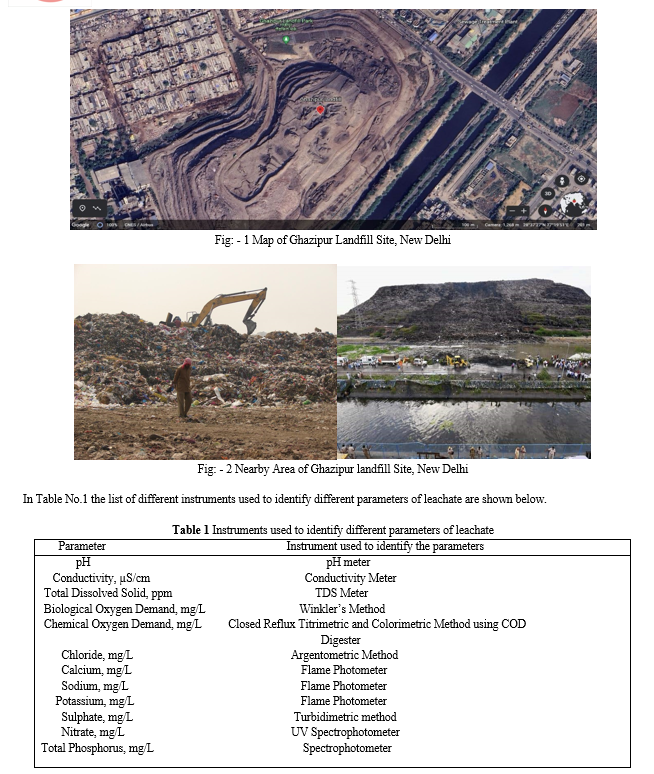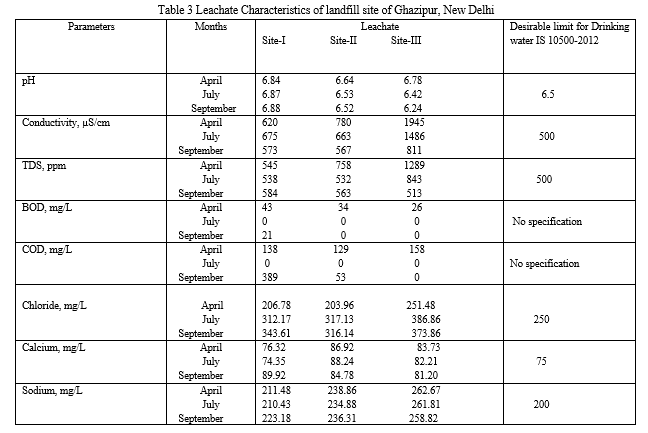Ijraset Journal For Research in Applied Science and Engineering Technology
- Home / Ijraset
- On This Page
- Abstract
- Introduction
- Conclusion
- References
- Copyright
Leachate Characterization Generated from Municipal Solid waste at Landfill Site Ghazipur, New Delhi
Authors: Sharad Chaudhary
DOI Link: https://doi.org/10.22214/ijraset.2022.47342
Certificate: View Certificate
Abstract
The management of municipal solid waste (MSW) is one of the key environmental issues facing Indian cities, mostly as a result of the country\'s growing industrialisation and urbanisation. According to numerous studies, open dumps and landfills are used to dispose of around 90% of solid waste in an improper manner. Pollutants can escape a poorly constructed landfill in a number of ways. Leachate can escape from a landfill or dumpsite and contaminate groundwater and surface water if the soil above or below it is porous. Therefore, In this paper an attempt is made to characterize the leachate produced by municipal solid waste dumping site of Ghazipur, New Delhi which is located at Latitude: 28° 37\' 30.8784\". Longitude: 77° 19\' 40.764\" near the Delhi-UP border. In this investigation, about 12 leachate parameters were identified. Three sample sites at the bottom of the landfill, spaced 7 metres apart, were used to characterise the leachate samples. All of the leachate samples had an acidic pH value ranging from 6.24 to 6.88, it is discovered. All of the sample’s conductivity and total dissolved solids ranged from 567 to 1945 S/cm and 513 to 1289 ppm respectively. Similar dissolved ions such chloride, calcium, sodium, nitrate, and potassium were found in the leachate sample. The majority of the ions were discovered to be above the standards-permitted level. The present study concludes that characterization of landfill leachate is important to identify the most critical pollutants present in the leachate and thereby to introduce suitable and applicable technologies such as in-situ impermeable barriers etc.
Introduction
I. INTRODUCTION
One of India's biggest environmental issues is the management of municipal solid waste (MSW). Rapid urbanisation and population expansion in emerging nations are the causes of the increased pace of MSW creation. Solid waste management practises frequently involve the open dumping of solid trash. In India, roughly 0.15 million tonnes of MSW are produced each day. Only 5% of the entire amount of municipal garbage collected gets composted; on average, 94% is dumped on land. In India, MSW is produced on average at a rate of 0.35 to 0.60 kg per person each day. (Rathod. M., et al., 2013) Leachates produced during the first five years of garbage deposition on landfills have a pH range of 3.7–6.5, which is indicative of the presence of carboxylic acids and bicarbonate ions. The leachates eventually become neutral or hardly alkaline (pH 7.0-7.6). Organic matter (both biodegradable and not), inorganic contaminants, and hazardous substances make up landfill leachate (Umar. M., et al., 2010). Since the composition of landfill leachate varies from site to site, landfill leachate characterization is essential for having a suitable treatment plant. Due to variances in waste composition, precipitation, moisture content, climatic fluctuations, site hydrology, waste compaction, leachate interaction with the environment, etc., landfill leachate composition varies over time and from site to site (Umar. M., et al., 2010). Due to the increased capacity of landfills and lower cost compared to other waste management approaches, the dumping of solid waste in open or waste landfilling continues to be the most popular and cheapest method of disposing of MSW. Waste goes through a range of physical, chemical, and microbial changes once it is dumped in landfills. Leachate is a contaminated liquid that seeps from the bottom of solid waste and contains suspended particles as well as soluble organic and inorganic substances. Leachate may contaminate surface water and ground water resources by seeping through landfill liners and subsoil. (Peter. K., et al., 2002).
II. MATERIAL AND METHODS
The study area of Ghazipur landfill New Delhi is located at which was established in 1984, spans 70 acres. The landfill site had risen 65 metres in height as of 2019. The national capital generated 10,990 tonnes per day (TPD) of municipal solid waste (MSW) in April 2021 on an average. The leachate samples were characterized by collecting twelve samples, collected from three different site at the bottom of landfill at a distance of 7 m on monthly interval i.e., April, July and September.

III. SAMPLE COLLECTION AND PRESERVATION
The standard procedure was followed when collecting the leachate sample. Leachate samples were collected in glass bottles for chemical analysis, while BOD and COD samples were maintained in plastic bottles covered with aluminium foil. (Naveen, B.P., et al., 2014). Leachate samples were collected for analysis, and to preserve the samples, a few drops of strong nitric acid were applied. In cooler boxes kept at a temperature below 5° C, the samples were then delivered right away to the lab. Before beginning the analysis, the leachate sample was kept in a refrigerator at 4 degrees Celsius. The testing of water and waste water is conducted in accordance with industry standards.

The characteristics of the leachate collected from the Ghazipur Landfill site are displayed in Table No. 3. Three separate locations' leachate samples were used to calculate the various pollutant values, which are tabulated. The observed results are compared to the desired drinking water quality limit set forth in IS 10500-2012. The majority of the leachate's parameters are found to be over the desired level in Table No. 2, which suggests that the landfill site's release of leachate could potentially contaminate surrounding water sources.


IV. RESULT AND DISCUSSION
- pH: All of the leachate samples had an acidic pH value (6.24-6.88), indicating that the age of the landfill is medium (5–10 years) (Ahmed. K., 2008). The biological breakdown of organic nitrogen into ammonium nitrogen causes the pH of landfill leachate to rise with landfill age. The pH fluctuation was probably brought on by a variety of elements, including dilution effects and rainwater infiltration.
- Conductivity and Total dissolved solids: These variables, which are used to determine the level of salinity and mineral contents of the sample, are often influenced by the total amount of dissolved organic and inorganic components present in the leachate. Due to the presence of potassium, sodium, chloride, nitrate, sulphate, and ammonia salts, the leachate has a salt content. The conductivity and total dissolved solids (TDS) values for the leachate sample are 567 to 1945 S/cm and 513 to 1289 ppm, respectively. The majority of the sites' conductivity and TDS values throughout various months show that they are above the permitted range specified by IS 10500.
- Major Anions: The ease with which the inorganic constituents in the MSW materials can be leached and the landfill's stabilisation procedure determine the degree of inorganic elements in leachate. In this investigation, it was discovered that the leachate sample had high quantities of all main anions, including chlorides, nitrates, and sulphates. The highest concentrations of chlorides (up to 386.86 mg/L) and nitrate (up to 7.89 mg/L) are found here. The presence of soluble salts in the research area is indicated by the high chloride level of the leachate sample. Sulphate is mostly produced by the decomposition of organic matter, soluble wastes like building debris or ash, artificial detergents, and inert waste. The type of nitrogen that is most oxidised in natural systems is represented by nitrates. It suggests pollution from domestic and agriculture. The ranges for nitrate and sulphate were discovered to be 0 to 7.89 mg/L and 207 to 328 mg/L, respectively. It was discovered that most of the locations had chloride and sulphate values that were higher than allowed. system.
- Major Cations: The main cations found in leachate are typically calcium, sodium, and potassium constituents. A range of 74.35-89.92 mg/L, 210.43-262.67 mg/L and 201.92-218.41 mg/L for calcium, sodium, and potassium were discovered. These cations are concentrated in leachate at different rates depending on the waste's makeup and the current stage of stabilisation in the landfill. During this study, there were notably high concentrations of calcium, sodium, and potassium. These ions most likely come from home garbage and leftover vegetable matter. Potassium exposure from more potassium in drinking water can have negative effects. Diseases including kidney failure, heart disease, coronary artery disease, hypertension, and diabetes can all be brought on by it. An adequate intake of sodium is necessary for optimal health, but too much of it can also lead to issues like hypertension. Sodium is an essential nutrient. One of the key cations that might contribute to water hardness is calcium, along with magnesium.
- Total Phosphorus: According to IS 10500 standards, phosphorus has no fixed value. Eutrophication, one of the main problems with lake and reservoir water quality, can be brought on by phosphorus that is carried from leachate to water sources. The study's measurement of phosphorus ranged from 0 to 5.78 mg/L.
- Indication from BOD and COD values: The BOD/COD ratio reveals the waste fill's age (Hui T.S., 2005). The ratio of BOD5/COD can be used to gauge the biodegradability of wastes. This study's BOD5/COD ratio ranges from (0-0.4), indicating that the landfill is medium-aged (5-10 years).
Conclusion
1) The Ghazipur New Delhi dump is an un-engineered open dump. They lack a leachate collecting and treatment mechanism as well as a bottom liner. As a result, all of the leachate produced finds a way to enter the environment. 2) To determine the site\'s potential for pollution, leachate samples from the area were collected and subjected to various physico-chemical analyses. It has been determined that the leachate sample contains several elements in excess of what is allowed. Before being released, the leachate samples would require an adequate treatment method to reduce the contaminants to a low level. 3) Leachate should not percolate into the subsurface, hence engineered landfill sites should be equipped with an impermeable liner and drainage system at the base of the dump. 4) The present study concludes that characterization of landfill leachate of Ghazipur New Delhi is important to identify the most critical pollutants present in the leachate.
References
[1] APHA 1998, Standard Methods for Examination of Water and Waste Water, 19th edition, American Public Health Association, Washington, DC. [2] Ahmed.K, 2008.TheKanoPhysicalEnvironmental, Available at: http://www.kanostate.net/physical.html [3] Barjinder, B., Saini, M.S., Jha, M.K., 2014. Assessment of Municipal Solid Waste Landfill Leachate Treatment Efficiency by Leachate Pollution Index, International Journal of Innovative Research in Science, Engineering and Technology (An ISO 3297: 2007 Certified Organization) Vol. 3, Issue 1, January 2014. [4] Barjinder, B., Saini, M.S., Jha, M.K., 2012. Characterization of Leachate from Municipal Solid Waste Landfilling Sites of Ludhiana, India: A Comparative Study, International Journal of Engineering Research and Applications (IJERA) ISSN: 2248-9622 Vol. 2, Issue 6, November- December 2012, pp.732-745. [5] Barjinder, B., Saini, M.S., Jha, M.K., 2013. Effect of Age and Seasonal Variations on Leachate Characteristics of Municipal Solid Waste Landfill. International Journal of Research in Engineering and Technology eISSN: 2319-1163 | pISSN: 2321-7308. [6] Draft Indian Standard, Drinking Water – Specification (Second Revision of IS 10500). [7] Goswami, D., Choudhury, B.N., 2013. Chemical Characteristics of Leachate Contaminated Lateritic Soil. International Journal of Innovative Research in Science, Engineering and Technology Vol. 2, Issue 4, April 2013 ISSN: 2319-8753. [8] Hui T.S, 2005. Leachate Treatment by floating Plants in Constructed Wetland, Master\'s Thesis, University Technology Malaysia. [9] Kenli, B., Bharti, A., 2012. Quantitative and Qualitative Study of MSW from Papum pare District in Arunachal Pradesh, International Journal of Innovative Research in Science, Engineering and Technology an ISO 3297: 2007 Certified Organization Volume 3, Special Issue 4, March 2014 National Conference on Recent Advances in Civil Engineering (NCRACE-2013). [10] Merwan, R., Harshit, M., Subhankar, K., 2013. Leachate Characterization and Assessment of Water Pollution near Municipal Solid Waste Landfill Site, International Journal of Chemical and Physical Sciences IJCPS Vol. 2, Special Issue - March 2013 ISSN:2319-6602. [11] Naveen, B.P., Sivapullaiah, P.V., Sitharam, T.G., Ramachandra, T.V., 2014. Characterization of Leachate from Municipal Landfill and its Effect on surrounding water bodies, LAKE 2014: Conference on Conservation and Sustainable Management of Wetland Ecosystems in Western Ghats. [12] Peter, K., Morton, A.B., Alix, P. R., Anders, B., Anna, L., Thomas, H.C.,2002. Present and Long-Term Composition of MSW Landfill Leachate: A Review, Critical Reviews in Environmental Science and Technology, 32(4):297–336. [13] Raghab, S., M., Abd El Meguid, A., M., Hegazi, H., A.2013. Treatment of Leachate from Municipal Solid Waste Landfill. HBRC journal http://dx.doi.org/10.1016/j.hbrcj.2013.05.007. [14] Umar, M., Aziz, H.A., Yusoff, M.S., 2010. Variability of Parameters Involved in Leachate Pollution Index and Determination of LPI from Four Landfills in Malaysia. International Journal of Chemical Engineering. 2010.
Copyright
Copyright © 2022 Sharad Chaudhary. This is an open access article distributed under the Creative Commons Attribution License, which permits unrestricted use, distribution, and reproduction in any medium, provided the original work is properly cited.

Download Paper
Paper Id : IJRASET47342
Publish Date : 2022-11-06
ISSN : 2321-9653
Publisher Name : IJRASET
DOI Link : Click Here
 Submit Paper Online
Submit Paper Online

